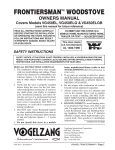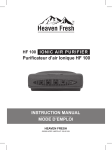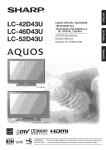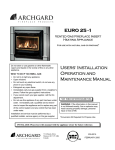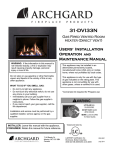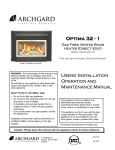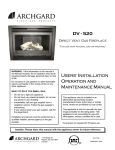Download Archgard CHALET 1600 Specifications
Transcript
CHALET 1600I WOOD Fireplace Insert Shown with optional nickel door (10-0203) and brushed nickel fan inlay (40-1103) Users’ Installation Operation and Maintenance Manual PRIOR TO FIRST FIRE: Remove all labels from glass. Clean fingerprints from plated surfaces with a glass cleanser and soft cloth to prevent permanent staining. CHILDREN AND ADULTS SHOULD BE ALERTED TO THE HAZARDS OF HIGH SURFACE TEMPERATURES, ESPECIALLY THE INSERT GLASS, AND SHOULD STAY AWAY TO AVOID BURNS OR CLOTHING IGNITION. KEEP ALL SMALL PARTS AWAY FROM CHILDREN WHILE ASSEMBLING SINCE THEY CAN CAUSE A CHOKING HAZARD. Installer: Please complete the details on the back cover and leave this manual with the homeowner. Homeowner: Please keep these instructions for future reference. 7116 Beatty Dr Mission, BC V2V 6B4 Canada 200-0258 SEPT 2013 Chalet 1600I 2 TABLE OF CONTENTS Important Safety Notes 4 Rating Plate Label 5 Dimensions 6 Specifications 6 Clearances 7 COMPONENT INSTALLATION / MAINTENANCE AND OPERATION METHODS Door Installation and Assembling 11 Air Tube And Ceramic Baffle Installation and Removal 12 Blower / Fan Installation 13 Blower Operation & Diagram 13 Face Plate Installation and Assembling 14 First Fire And Operation of Insert 15 Brick Removal And Installation 19 Door And Glass Maintenance 20 Paint 21 INSERT INFORMATION FOR INSTALLATIONS Venting Requirements 9 Precautions For Installation 8 Installation Methods 10 TROUBLESHOOTING / SAFETY / CHIMNEY AND WOOD Troubleshooting 16 Creosote & Chimney Fires 17 Safety Equipment 17 Chimney Maintenance 18 wood 18 Ash Disposal 19 ACCESSORY / PARTS REPLACEMENT Accessory & Replacement Parts List 22-23 Archgard Warranty 24 Warranty Registration Card 25 Notes 26 Installation Information 27 Chalet 1600I 3 ARCHGARD CHALET 1600I WOOD FIREPLACE INSERT Surround Trim 6” Flue Adapter Kit Chalet 1600I Blower Congratulations on choosing a state-of-the-art Archgard Hearth Product! The hand crafted Archgard CHALET 1600I WOOD Fireplace Insert has been designed to provide you with comfort, security and economy for many years of trouble-free enjoyment. It has been our experience that the overall enjoyment of your new appliance will be greatly enhanced by becoming familiar with its installation, operation and maintenance. Prior to installation, we ask that you take a few moments to read this manual. We wish you and your family many years of enjoyment in the warmth and comfort of this hearth appliance. Thank you for choosing Archgard Industries! Chalet 1600I IMPORTANT SAFETY NOTES 1. 2. 3. 4. 5. 6. 7. 8. 9. 10. 11. 12. 13. When installing your insert, particular attention should be paid to fire protection. If this room heater is not properly installed, a house fire may result. To reduce the risk of fire, follow the installation instructions. Contact local building, fire officials or the authority having jurisdiction about restrictions, installation, inspection and permit requirements in your area. CAUTION: Never use gasoline, gasoline-type lantern fuel, kerosene, charcoal lighter fluid, or similar liquids to start or “freshen up” a fire in this heater. Keep all such liquids well away from the heater while it is in use. DO NOT BURN GARBAGE OR FLAMMABLE FLUIDS SUCH AS GASOLINE, NAPHTHA OR ENGINE OIL. Do not burn treated wood, or salt laden (driftwood, etc.) wood. Burning materials other than wood (including charcoal) under adverse conditions may generate carbon monoxide in the home, resulting in illness or possible death. Your insert should burn dry, standard firewood only. The use of cut lumber, plywood, “mill ends”, etc. is not recommended as this fuel can easily overheat your wood insert. Chemically treated fire logs must not be burned in your wood insert. Do not store any fuel within space heater installation clearances or within the space required for charging and ash removal. Do not place wood, paper, furniture, drapes or other combustibles near the appliance. During operation, if any part of the insert starts to glow, the insert is in an over-fired condition. Close the air control completely by pushing it in until the glowing has stopped. OVERFIRING VOIDS YOUR WARRANTY and can be hazardous! WARNING: Do not operate with insert door open. It can over fire your appliance, gas and flame may be drawn out of the fireplace stove opening, creating risks from both fire and smoke. WARNING! Never draw outside combustion air from a wall, floor or ceiling cavity or from any enclosed space such as an attic or garage or carport. Check your chimney system thoroughly when installing into an existing masonry chimney. Seek professional advice if in doubt about its condition. Comply with all minimum clearances to combustibles as shown in this manual. Build fire on brick firebox floor. Do not use grates, andirons or other methods to support fuel. HOT WHILE IN OPERATION! Keep children, pets, clothing and furniture away. Contact can cause skin burns. Do not operate without fully assembling all components. Doing so will void your warranty, and could 4 present a serious safety hazard. 14. Solid fuel-burning appliances shall be installed in such a manner as to provide ventilation and combustion air supply to allow for the proper combustion of fuel, chimney draft and the maintenance of safe temperatures. 15. The controls of your unit or the air supply passages should not be altered to increase firing for any reason. 16. If you burn the unit too slowly or at too low a setting your unit will not be operating as efficiently as it can. An easy rule of thumb says that if your glass is clean, then your flue is clean and your exhaust is clean. Burn the insert hot enough to keep your glass clean and you won't need to clean your flue as often. 17. Check you chimney twice a month for creosote accumulation and sweep as required. 18. Burning wet or green, unseasoned wood, could cause excessive creosote accumulation in the flue pipe and chimney. This could result in a chimney fire. Store wood in a dry location. 19. Do not permit creosote or soot build-up in the chimney system. Check and clean chimney at regular intervals. Failure to do so can result in a serious chimney fire. 20. Ashes should be disposed of carefully, using a metal container. 21. Do not install in a mobile home. 22. Do not connect to any air distribution duct or system. 23. Do not connect this unit to a chimney flue already serving another appliance. 24. This appliance must be connected to a chimney and terminate to the outside of the building envelope. Never vent to another room or inside a building. 25. Do not operate if the gasket on the door is missing or damaged. Use only manufacturers approved parts. 26. Do not operate with broken glass. Use only manufacturers approved replacement parts. 27. Do not use “Black” or “Galvanized” pipe in your flue system. 28. For further information refer to NFPA 211 (USA), CAN/CSA-B365 (Canada) or any other appropriate local codes. Chalet 1600I 5 YOUNG CHILDREN SHOULD BE CAREFULLY SUPERVISED WHEN THEY ARE IN THE SAME ROOM AS THE APPLIANCE. EMISSIONS FROM BURNING WOOD OR GAS COULD CONTAIN CHEMICALS KNOWN TO THE STATE OF CALIFORNIA TO CAUSE CANCER, BIRTH DEFECTS OR OTHER REPRODUCTIVE HARM. READ ALL INSTRUCTIONS BEFORE INSTALLING AND USING THIS APPLIANCE. FAILURE TO FOLLOW INSTRUCTIONS MAY RESULT IN PROPERTY DAMAGE, BODILY INJURY, OR EVEN DEATH. SAFETY NOTE: If this insert is not properly installed, a house fire may result. For your safety, follow the installation instructions. Contact your local building or fire officials, or any other authority having jurisdiction about restrictions and permit/inspection requirements in your area. WHEN LOCATING YOUR INSERT: Consider safety and the fact that the insert will need a chimney. It is a good idea to plan your installation on paper, using exact measurements for clearances and floor protection before actually beginning the installation. These installation instructions describe the installation and operation of the Archgard CHALET 1600I WOOD Fireplace Insert. This insert meets the U.S. Environmental Protection Agency’s 1990 particulate emission standards. It is also listed by Lab Test Laboratories, Inc. to UL Safety Standard 1482 and ULC S628. It also meets the requirements of (UM) 84-HUD. SAFETY LABEL A copy of the label that accompanies each Archgard Chalet 1600I WOOD Fireplace Insert , is printed here for your convenience. NOTE: Archgard units are constantly being improved. If there is a conflict between the label on the unit and the one printed here, the label on the unit is the correct one. The safety label is attached to the side of the unit. This unit has been approved for use in Washington State ,USA. 2013 2014 2015 Chalet 1600I 6 DIMENSIONS SPECIFICATIONS 40" 1016mm SEE NOTE B 23 3/4" 603mm MODEL 28" 711mm SEE NOTE B CHALET 1600I WOOD FIREPLACE INSERT HEIGHT OF BODY 18 5/8” (473 mm) WIDTH of BODY 23 3/4” (603 mm) DEPTH of BODY 23 3/8” (595 mm) E.P.A. EMISSIONS E.P.A. OUTPUT RATING NOTE B: OPTIONAL 46" (1168mm) WX 32" (813mm) H SURROUND. 18 5/8" 473mm 17 7/8" 454mm 15 7/16" 392mm SEE NOTE A NOTE A: SURROUND DEPTH IS ADJUSTABLE. 12 7/16" TO 15 7/16" (316mm TO 392mm) 6" 152mm 23 3/8" 595mm 20 11/16" 525mm O 20" 508mm 2.88 g/hr 6" 152mm 63 % APPROXIMATE HEATING AREA 800—1500 square feet DURATION ON LOW FIRE 6—10 hours INSERT BODY WEIGHT WITH PACKAGING 300 lbs Surround Panels Standard (width x height) 40” W X 28” H (1016 mm W x 711 mm H) Optional (width x height) 46” W X 32” H (1168 mm W x 813 mm H) Chalet 1600I 7 Minimum Fireplace Size Your fireplace opening requires the following minimum sizes: Height Width Depth From back of adjustable faceplate to front of flue collar 18 3/4” 476.25 mm) 24” (609.6 mm) 13” (330.2 mm) 3 1/2” — 6 1/2” (88.9 mm — 165.1 mm) Minimum Clearances To Combustible Materials (Measured From Insert Body) Side Wall to Insert Top of Insert to =A Bottom of Mantle (12”) =B 8.5” (216 mm) 21” (534 mm) Side of Insert to Mantle Leg =C 8.5” (216 mm) Hearth Extension Front =D Hearth Extension Side =E Canada = 18” (450 mm) Canada = 8” (200 mm) USA = 16” (400 mm) USA = 8” (200 mm) *see note 1 Note 1: If insert to floor is less than 4” the unit requires 0.5” of k = 0.84 (Btu)(in)/(Ft 2)(hr)(°F) thermal protection. How to determine if alternate floor protection materials are acceptable. All floor protection must be non-combustible (i.e., metal, brick, stone, mineral fiber boards, etc.) Any organic materials (i.e., plastics, wood paper products, etc.) are combustible and must not be used. The floor protection specified includes some form of thermal designation such as R-value. (thermal resistance) or k-factor (thermal conductivity). PROCEDURE: 1. Convert specification to R-value i. R-value given—no conversion needed. 1 ii. k-factor is given with a required thickness (T) in inches R = k x T 1 Iii. K-factor is given with a required thickness (T) in inches: R = K x 12 x T Iv. R-factor is given with a required thickness (T) in inches: R= r x T 2. Determine the R-value of the proposed alternate floor protector. i. Use the formula in step (1) to convert values not expressed as “R” Ii. For multiple layers, add R-values of each layer to determine overall R-value. 3. If the overall R-value of the system is greater than the R-value of the specified floor Protector , the alternate is acceptable. EXAMPLE: The specified floor protector should be 3/4-inch thick material with a k-factor of 0.84. The proposed alternate is 4” brick with a r-factor of 0.2 over 1/8” mineral board with a k-factor of 0.29. Step (a): Use formula above to convert specification to R-value. 1 1 R = k x T = 0.84 x 0.75 = 0.893 Step (b): Calculate R of proposed system. 4” brick of r = 0.2, therefore: 1 R Mineral board = 0.29 x 0.125 = 0.431 R Total = R brick + R mineral board = 0.8 +0.431 = 1.231 (continued on next page) Chalet 1600I R R Total = brick + 8 R mineral board = 0. 8 + 0.431 = 1.231 R R Step ( c ): Compare proposed system total of 1.231 to specified R of 0.893. Since proposed system total is greater than required , the system is acceptable. DEFINITIONS: R = ( ft ² )(hr)(°F) Btu (Btu) (in) ( ft (Btu) (ft) ( ft ² ) (hr) (°F) k = K X 12 K= ( ft ² ) (hr) (°F) r = (Btu) (in) = 1 k B C A D E Hearth Protection In the USA, the floor protection must be made of non-combustible material and must extend 16" in front and 8” beyond each side of the fuel loading and ash removal openings. Consult with your local inspector/ authority having jurisdiction or check the NFPA 211 or local codes. In Canada, the floor protection must be made of non-combustible material and must extend 18" (450mm) in front and 8” beyond each side of the fuel loading and ash removal openings. A 0.38 mm (0.015 in) thick metal sheet or a grouted ceramic floor-tile surface installed in accordance with recognized Building Codes shall be considered a durable pad. A floor pad shall not be placed on top of a carpet unless the pad is structurally supported to prevent displacement and distortion. Consult with your local inspector or check the CSA B365. All floor protection must be non-combustible (i.e. metals, brick, stone, mineral fiber boards, etc.). Any organic materials (i.e., plastics, wood paper products, etc.) are combustible and must not be used. Chalet 1600I BEFORE INSTALLING AND USING THIS APPLIANCE. The installation of Smoke and Carbon Monoxide detectors along with a minimum of a five pound fire extinguisher is highly recommended in any home. When you first fire up your CHALET 1600I WOOD Fireplace Insert, you may notice the smoke detectors operating more frequently. This may be due to the curing of stove paint or oils from manufacturing or fumes caused by accidentally leaving the door open. Do not disconnect the detectors. Consult local building or fire officials about restrictions and installation inspection and permit requirements in your area. Let your home insurance company know that you plan to install this CHALET 1600I WOOD Fireplace Insert in your home. Please read this entire manual before you install and use this CHALET 1600I WOOD Fireplace Insert in your home. Failure to follow instructions may result in property damage, bodily injury or even death. 9 extension with a heavy blanket or carpet scrap during the installation. This fireplace insert must be installed with a continuous chimney liner of 6” diameter extending from the fireplace insert to the top of the chimney. The chimney liner must conform to the Class 3 requirements of CAN/ULC-S635, Standard for Lining Systems for Existing Masonry or Factory-Built Chimneys and Vents, or CAN/ULC-s640, Standard for Lining Systems for New Masonry Chimneys. RECOMMENDED MINIMUM CHIMNEY HEIGHTS The chimney must be at least 3 ft. (.9m) higher than the highest point where it passes through the roof and at least 2 ft. (.6m) higher than the highest part of the roof or structure within 10 ft. (3m) of the chimney, measured horizontally. These are code requirements and cannot guarantee a suitable draft. We recommend using a minimum total system height of 12 ft. (3.6m), measured from the flue collar to the bottom of the chimney cap). And extend Install and use only in accordance with manufacturer’s 2’ above the overall highest living space. installation and operating instructions. CHALET 1600I WOOD Fireplace Insert is designed to be installed into a masonry or factory built zero-clearance fireplace. Have the chimney and fireplace inspected and swept prior to installing the Insert to be sure that the chimney/fireplace meets requirements of the Standard of Chimneys, Fireplaces, Vents and Solid Fuel Burning appliances, N.F.P.A. 211 (Latest Edition) or applicable National, Provincial, State or local codes. The installation shall conform to CAN/CSA-B365, Installation Code for Solid-Fuel Burning Appliances and Equipment. The factory built zero-clearance fireplace and its chimney must be listed per UL 127 or ULC S610 Standards. WARNING: Under no circumstances is this heater to be installed in a makeshift or temporary manner. Do not connect the insert to a chimney system servicing another appliance. The chimney damper may be removed or lock in the open position to install the chimney liner. Check local codes first. A permanent metal warning label must be attached to the back of the fireplace stating that the fireplace may have been altered and may be unsafe to use without the insert. Do not use unlabelled parts, or substitute parts made for another chimney system. Install only to liner/chimney manufacturer's installation instructions. The chimney must be suitable for wood burning use. Check for creosote build up or other obstructions. The insert is very heavy and will require two or more people to move it into position. Be sure to protect your hearth Chalet 1600I 10 Installing Into a Masonry Fireplace Inspect your fireplace for cracks, loose mortar or other 1) The fireplace must not be altered, except for the excepphysical defects. If repairs are required, they should be tion listed below. The permanent metal warning label completed before installing your insert. provided must be attached to the back of the fireplace, stating that the fireplace may have been altered to acThe Insert must be installed in accordance with local and or commodate the insert, and must be returned to original national building codes. CHALET 1600I WOOD Fireplace condition for use as a conventional fireplace. The folInsert is only certified with the use of a full liner. A full liner lowing modifications of factory built fireplaces are perprovides the safest installation and optimizes draft condimissible; removal of damper, removal of smoke shelf or tions and performance. When connected to a full liner, the baffle, removal of ember catches, removal of fire grate, Insert is able to draft correctly and will help to prevent probremoval of viewing screen/curtain, and removal of lems such as difficult start-ups and smoking out the door. doors. 2) The factory built chimney must be listed per UL 127 WARNING: Do not remove bricks and mortar from the ex(US), or ULC S610 (CA) and meet type HT requireisting fireplace. (Exception: Masonry or steel, including the ments of UL 103 (US). Factory built fireplace chimneys damper place, may be removed from the smoke shelf and tested to UL 127—1998, may be at the fireplace manuadjacent damper frame if necessary to accommodate a facturer’s option, tested to the same criteria as UL 103 chimney liner, provided that their removal will not weaken HT requirements. If the chimney is not listed as meetthe structure of the fireplace and chimney, and will not reing HT requirements, or if the factory built fireplace was duce protection for combustible materials to less than that tested prior to 1998, a full height listed chimney liner required by the National Building Code.) must be installed from appliance flue collar to the chimney top. The liner must meet type HT requirements Full Liner Installation (2100°F) per UL 1777 (US). The liner must be securely 1) Install flex liner into existing chimney as per liner manuattached to the insert flue collar and the chimney top. facturer’s specification. To prevent room air passage to the chimney cavity of the fireplace, seal either the damper area around the 2) Install the supplied flue adaptor kit to the end of the flex chimney liner with high temperature sealant of the fireliner. Drill two 7/16” diameter holes through the liner at place front with fiberglass batting. the height required. Remember to consider the length of the crimp and the depth of the collar. Insert steel rod through the 7/16” holes and secure with the washers and nuts. Be sure NOT to over tighten the nuts as this may distort the pipe. 3) Push the Insert into position, use the rear adjusting legs to level the Insert. 4) To secure Flue Adaptor, remove the insert baffle plates and air tubes. Insert the flue adaptor into the flue collar opening and pull down hard to seat the adaptor. Hook Flue Adaptor Kit. the top end of the curved steel bar over the crossbar already in position. Slide the remaining bar with nut welded to its center over the curved hanging steel bar and thread on the remaining washer and nut. Tighten the bottom nuts unit the adaptor is firmly in position. It may be necessary to cut some length of the end of the rod hanging into the firebox. 5) Seal off chimney top and liner with manufacture’s termination. Attach rain cap and install storm collar if desired. 6) Reinstall bricks, air tubes and baffle plates to its correct position. 7) Finish by installing faceplate and door. Installing Into a Factory Built Fireplace Full Flue Liner CHALET 1600I WOOD Fireplace Insert may be installed into a factory built zero clearance fireplace (size permitting) with the following requirements. The factory built zero clearance fireplace must be listed per UL127 or ULC S610 standards. Chalet 1600I 11 The door comes assembled with the glass and gasket. Clevis Pin Washer Roller Cotter pin goes through clevis pin as shown here: Cotter Pin 1. Run the threaded end of the handle through the hole in the cast door. 2. Insert the clevis pin into the roller and washer. 3. Insert the end of the clevis pin assembly into the hole in the end of the handle 4. Close the door and see how the door closes. If it is too tight, turn the handle clockwise to loosen it. If it is too loose, turn the handle counter clockwise to bring the door closer to the stove body. 5. To verify that the doors are well sealed, insert a piece of paper between the door and the stove body. You shouldn’t be able to pull the paper out. Tighten it to the point where the paper is starting to tear when you are pulling it out. 6. Insert the cotter pin into the end of the clevis pin to keep the assembly from coming apart. 7. Attach spring handle by rotating the spring counter clockwise onto the rod. Ensure that the spring screws onto the rod at least ½”. 9. Cover the holes with the two decorative plug buttons CAUTION: THIS UNIT CONTAINS SMALL PARTS DURING ASSEMBLY THAT SHOULD BE KEPT AWAY FROM CHILDREN DUE TO CHOKING HAZARD WHICH COULD RESULT IN PERSONAL INJURY OR DEATH. Chalet 1600I 12 Door Adjustment This fireplace has door hinges that have been designed to accept field adjustment. To adjust a mis-aligned door, place a piece of 2x4 wood up against one of the hinges. Using a large hammer and adequate force, strike the wood that is up against the hinge. By adjusting the bottom hinge to the left, it will lift the left side of the door up. This can be done with both upper and lower hinges adjusting the hinges left or right to level the door. Chalet 1600I 13 AIR TUBE INSTALLATION The Air Tubes in the Archgard Chalet 1600I come already assembled with the baffle plates installed. If for some reason they need to be removed or installed, the following guidelines must be adhered to. (The stove must be cool) 1) Open the Archgard Freestanding Chalet 1600I door. 2) NOTE: The holes in the two back tubes are larger than the holes in the front tube. The left hand side of the tubes have little “notches” or “relief's” cut into them that mate with the left hand side of the stove that align the air hole for proper combustion. 3) The 2 ceramic baffles are fragile and must be installed as shown below. They are installed prior to putting in the last tube in the front position. 4) Slide the first rear tube into the right hand side hole, as far as possible and then bring it back into the hole on the left hand side lining up the “relief or notch” cut into the tube on that side until it locks into position. If the tube will not slide in easily, simply use a pair of vise grips or pliers and tap it into place with a hammer. Then insert the cotter pin from the top through the hole. 4) Before installing the final air tube, slide the a lightweight baffle plate over the air tubes (leaving the step joint in the middle) from the front and then push it to the back and over to side of the stove as far as it can go. Do the same with the other lightweight baffle plate ensuring that the step in the middle will overlap the previous lightweight baffle plate. 5) When both lightweight baffle plate are in, install the third secondary air tube. Handle the ceramic baffle plates with care as they are fragile. Notches Cotter Pins Baffles shown in proper position. Chalet 1600I 14 To install or remove the fan module: 1) Remove fan assembly from packaging and inspect to ensure no damage has occurred inside the package. Please report any damage immediately to your Authorized Archgard Dealer. 2) Align fan assembly with the clips at the bottom of the ash lip. Slide assembly into position. Install four screws at each side to mount fan assembly as shown. 3) Making sure that wires cords are not caught or pinched into the fan or housing. Call your dealer if you require assistance. CAUTION: The connection cord should not be routed under or in front of the assembly and also kept away from any hot surfaces. Do not route cord under or in front of unit. FAN OPERATION The CHALET 1600I WOOD Fireplace Insert must be electrically grounded in accordance with local codes or, in the absence of local codes, with the National Electrical Code, ANSI/NFPA 70, or the Canadian Electrical code, CSA C22.1. CAUTION: Label all wires prior to disconnection when servicing controls. Wiring errors can cause improper and dangerous operation. WARNING: Electrical Grounding Instructions This appliance is equipped with a three-pronged (grounding) plug for your protection against shock hazard and should be plugged directly into a properly grounded three-prong receptacle. Do not cut or remove the grounding prong from this plug. Electrical Rating = 115/120V ~ 60 Hz 55W Fan Output Rating = 136 c.f.m. FAN WIRING SPEED CONTROL 110vF (43vC) THERMAL SNAP SWITCH LINE GROUND NEUTRAL TO APPLIANCE CONVECTION FAN Chalet 1600I FACEPLATE INSTALLATION NOTE: There is 3 1/2” to 6 1/2” of adjustability between the back of the faceplate and the front of the flue collar. The faceplate box will have all required hardware for installation. 1) Start the installation by remounting the 4 angle clips into the predrilled holes in the top and bottom of each side of the insert as shown. The faceplate will mount flush with the surface it is covering. Take this into account when adjusting the 4 mounting brackets. 2) Remove the Faceplate and Louver assembly from the packaging. From the back, screw the louvered section to the top section of the faceplate as shown with 2 self tap screws. (complete surround not shown) 3) Start by placing some form of protection on top of the insert top so that the surface will not be scratched as you slide the faceplate and louvered section onto the top. Push the faceplate back until it contacts the 4 installed angle clips. Make sure that the faceplate is flush and even with the area it is covering. Adjust the clips as required. Remove the material used as protection and using 4 black supplied screws install the faceplate to the brackets. 15 BLOWER / FAN ASSEMBLY AND REMOVAL. (MODULE COMES PACKED IN FIREBOX ) The CHALET 1600I WOOD Fireplace Insert is certified for operation with or without the fan. CAUTION: Do not plug in Fan Module until full Insert installation has been completed. If servicing is required or if you need parts contact your dealer or installer. To switch the power cord to the right side: 1) Remove the strain relief with a pair of slip-joint pliers. 2) Disconnect all connections and remove power cord by pulling it out of the hole. 3) Insert power cord from the hole on right side and reconnect all connections. 4) Secure power cord with strain relief. Chalet 1600I VENT SPECIFICATIONS Your CHALET 1600I WOOD Fireplace Insert was designed for and tested on a 6” (152mm) chimney, 15’ (4.57m) high, (includes insert height) measured from the base of the insert. The further your stack height or diameter varies from this configuration, the greater the possibility of performance problems. In addition, exterior conditions such as roof line, surrounding trees, prevailing winds and nearby hills can influence insert performance. Your local dealer is the expert in your geographic area and can usually make suggestions or discover solutions that will correct any flue problem you may have, allowing your wood insert and its flue system to operate correctly and provide safe and economical heat for your home. OPERATION Air quality is important to all of us, and if we choose to use wood to heat our homes, we should do so responsibly. To do this, we need to learn to burn our inserts in the cleanest way possible. Doing this will allow us to continue using our wood inserts for many years to come. WARNING: Do not operate with insert door open. It can over fire your appliance, gas and flame may be drawn out of the fireplace stove opening, creating risks from both fire and smoke. AIR CONTROL - PRIMARY AIR SYSTEM (DRAFT CONTROL) 16 FIRST FIRE 1. The first step in building a fire is to open the air control. 2. Crumple four or five sheets of newspaper and put them on the firebox in the centre of the heater (never use a grate or build the fire off the floor of the insert)– be generous and you will have more success. Hold the paper down with 10 to 15 pieces of dry kindling. Softwoods, such as cedar and pine, make good kindling (use the species available in your region). Place the kindling on and behind the newspaper, so that the combustion air reaches the newspaper first where you light it. It is also a good idea to add one or two small pieces of dry firewood to the kindling load before lighting. 3. Light the newspaper and close (but don’t latch) the door. When the paper is flaming brightly and the kindling catches and the chimney is producing strong draft, latch the door. CAUTION: Never leave the unit unattended if door is left open. This procedure is for start-up only, as the unit may over-heat if the door is left open for too long. 4. When the flames from the kindling load begin to subside, gradually add several small pieces of wood. Avoid smothering the fire with the new wood. Place the pieces on and behind the burning kindling. Wood should be flaming until it is reduced to charcoal. Never let a fire smoulder because smouldering wastes wood. For the first few hours, the insert will give off an odor from the paint. You may want to leave some windows and/or doors open to provide adequate ventilation while this temporary condition exists. In some instances, your smoke detector may alarm. Do not build hot fires in your insert for the first few days until the paint has had a chance to cure with some moderate fires. 5. Before opening your door to reload, open the draft fully for approximately 10 to 15 seconds until the fire has been reestablished. This will minimize any smoking. The primary air enters at the base of the firebox and travels through passages toward the upper front of the firebox, near the top of the glass door. This preheated air supplies the necessary fresh oxygen to mix with the unburned gases, helping to create secondary combustions. This air is regulated by the Primary Control at the bottom left side of the appliance. For more primary air, pull the control out. All fuel burning appliances consume oxygen during operaFor less air, push the control in. tion. It is important that you supply a source of fresh air to your unit while burning. Pull this control all the way out when first starting the insert. Once the fire has been established you may adjust this Ignore the fire until you notice the room, space or house control to set the burn rate of the fire. If this damper is cooling off. A new load cools the firebox, so it needs to be closed at first start-up, the fire will burn very slowly and heated up again. Then add the right amount of wood to suit could soot the appliance. the conditions. Wood burns best in cycles. A cycle starts When shutting down the insert, fully open the air control. when wood is placed on and behind a raked coal bed. A This allows the chimney temperatures to remain as high as cycle ends when the load is reduced to the same sized coal possible for as long as possible. Cold chimney tempera- bed. Do not force wood into the firebox to try and fill it. tures create creosote. We recommend that when you first fire up your CHALET 1600I WOOD Fireplace Insert, you leave a door and/or window open in order to vent the smoke that may be created from the unit’s paint curing. The paint will smell a little for the first burn or two as it cures. Chalet 1600I 17 TROUBLESHOOTING The most common factors for poor draft are: a) Air supply/House depressurization b) Environmental conditions c) Cold chimneys d) Poor chimney/connector installation/ design and maintenance a) b) c) d) Air supply / House depressurization – Inside the home, household appliances such as clothes dryers, bathroom fan, central vacuums, forced-air furnaces, etc, compete for air, resulting in air starvation to the fire. This creates a condition known as negative pressure. When a negative pressure situation is experienced, the combustion gases can be drawn from the chimney and into the house. This condition is commonly referred to as downdrafting. Increased amounts of insulation, vinyl windows and extra caulking in various places can all keep heat in but may also make a home more airtight. Seal the leaks that are high in the house because the house acts as a chimney and as hot air leaves the house at the ceiling level, more air comes in at lower levels to make up for the air that leaves. Make sure there is adequate air for the appliance in the house. Environmental Conditions - High trees, low-lying house location such as in a valley, tall buildings or structures surrounding your house and windy conditions can cause poor draft. Cold Chimney Temperature - Avoid cold chimney temperatures by burning a hot fire for the first fifteen to forty minutes, being careful not to over-fire the insert. Where possible, install a thermometer on or in the flue pipe so temperatures can be monitored. Chimney Installation and Maintenance - Avoid using too many elbows or long horizontal runs. Too short a chimney can cause difficult start-up, dirty glass, smoking when door is open, and even reduced heat output. Too tall a chimney may prompt excessive draft, which can result in very short burn times and excessive heat output. If in doubt, contact a chimney expert and/or chimney manufacturer for help. Clean chimney, rain caps and especially the spark arrestor regularly, to prevent creosote build-up, which will significantly reduce chimney draw. PROBLEM Glass is Dirty Low Heat Output Will not burn Overnight Cannot establish proper burn CAUSE CURE 1. Wood is wet Use dry wood 2. Turning down air control or damper too soon Do not turn down until: - there is a good bed of coals - the wood is charred 3. Draft too low – Improper chimney height and / or diameter - Chimney plugged or restricted, check flue - Provide outside air for combustion 4. Door gasket leakage - Replace gasket - Check latch 5. Excessive Creosote Buildup - See 1,2,3, above 1. Wood is wet - Use dry wood 2. Fire too small - Build a larger fire 3. Draft too low - Chimney plugged or restricted, inspect and clean 1. Air control is set too high - Set control lower 2. Not enough wood - Un-split wood is preferred for overnight burns 3. Draft too high - Excessive chimney height or small diameter 1. Combustion air supply blocked - Ensure adequate air is available for combustion 2. Draft too low - Chimney liner plugged or restricted, inspect and clean - Chimney liner oversized or otherwise unsuitable Chalet 1600I CREOSOTE AND CHIMNEY FIRES “CREOSOTE—FORMATION AND NEED FOR REMOVAL” 18 AVOIDING A CHIMNEY FIRE There are two ways to avoid chimney fires: When wood is burned slowly, it produces tar and other 1. Do not let creosote build up to a point where a chimorganic vapors, which combine with expelled moisture to ney fire is possible. form creosote. The creosote vapors condense in the 2. Do not have fires in the insert that may ignite chimrelatively cool chimney flue of a slow-burning fire. As a ney fires. These are hot fires, such as when burning result, creosote residue accumulates on the flue lining. household trash, cardboard, Christmas tree limbs, When ignited, this creosote makes an extremely hot fire. etc. The chimney and chimney connector should be inspected at least once every two months during the heating season to determine if a creosote buildup has oc- Remember, the Archgard CHALET 1600I WOOD Firecurred. If creosote has accumulated, it should be re- place Insert, is not a garbage burner. moved to reduce the risk of a chimney fire. IN CASE OF A CHIMNEY FIRE Chimney fires result from poor firing techniques combined with a lack of maintenance. If unseasoned wood 1. Prepare to evacuate to ensure everyone's safety. (wood that hasn't been dried enough) is burned slowly in Have a well understood plan of action for evacuation. an old "airtight" heater, creosote can build up quickly and Have a place outside where everyone is to meet. the risk of a chimney fire increases. When you operate 2. Close the air inlet on the insert. wood-burning appliances properly, some creosote may 3. Call local fire department. Have a fire extinguisher still be deposited, but it will be less combustible. Instead handy. Contact your local municipal or provincial fire of the black, tarry, highly flammable creosote from smolauthority for further information on how to handle a dering fires, proper firing may create small amounts of chimney fire. It is most important that you have a soft, flaky and dark brown deposits. clearly understood plan on how to handle a chimney fire. You can prevent chimney fires. Have your chimney 4. After the chimney fire is out, the chimney must be checked for creosote deposits regularly, until you find out cleaned and checked for stress and cracks before how quickly it builds up in the system. Conventional starting another fire. Also check combustibles around wood heaters can produce creosote quickly because they the chimney and the roof. can't burn the wood as completely as advanced combusThe services of a competent or certified installer, tion designs. In severe cases of smoldering, it may take (certified by the Wood Energy Technical Training proonly a few days for enough creosote to build up to sustain gram (WETT) – in Canada, National Fireplace Institute a chimney fire. The new, low-emission wood inserts, like (NFI) - in U.S.A.) are strongly recommended. the ARCHGARD CHALET 1600I Wood Fireplace Insert burn the wood so completely that, when operated properly, their chimneys normally need cleaning only once a SAFETY EQUIPMENT year. All homes with a fuel burning appliance should have at Never assume that the chimney is clean. Check it regu- least one fire extinguisher in a central location known to all larly to be sure, especially during the spring and fall. If you in the household along with a smoke detection device indo have a chimney fire, have the chimney inspected and stalled to the smoke detector manufacturer’s placement repaired, if necessary, before using the system again. A and installation instructions, and maintained on a regular chimney fire is a clear sign of a problem with the appliance, basis. the fuel or the way the system is operated. Make changes We also recommend all dwellings be equipped with a Carto avoid chimney fires in the future. Using an energy- bon Monoxide Detector and have a practiced evacuation efficient wood-burning appliance, like the Archgard CHA- plan. LET 1600I Wood Fireplace Insert , coupled with good installation and proper burning techniques, dramatically lowers the chance of a chimney fire. FAILURE TO INSPECT AND CLEAN YOUR CHIMNEY SYSTEM REGULARLY CAN RESULT IN A CHIMNEY FIRE, WHICH COULD DAMAGE THE CHIMNEY OR CAUSE A HOUSE FIRE. Chalet 1600I INSERT AND CHIMNEY MAINTENANCE It is very important to carefully maintain your Chalet 1600I insert, including burning seasoned wood and maintaining a clean insert and chimney system. Remove the fireplace insert periodically for the purpose of inspection. Have the chimney cleaned before the burning season and as necessary during the season, as creosote deposits may build up rapidly. Moving parts of your insert require no lubrication. Have the chimney system cleaned when a significant layer of creosote has accumulated (3 mm / ⅛" or more). At the end of the heating season, have the chimney/ insert system inspected and if necessary cleaned/ maintained. As a precaution, the chimney should be inspected at least once every month during the heating season to determine if creosote or soot has built up. Check spark arrestor screens at least every 2 to 4 weeks. If creosote or soot has accumulated, it should be cleaned or replaced to reduce the risk of chimney fire. Proper burning will leave the firebricks in the firebox a tan color, never black. Steel parts in the firebox will be light to dark brown, never black or shiny. Replace firebrick and baffles as necessary. 19 will be difficult to burn. Store two or three days' supply of wood indoors, making sure that it is clean and dry. In winter, when you bring wood directly in from the cold outdoors and immediately load it into the appliance, it may initially cool the fire and prevent proper combustion. Remember, storing wet wood indoors could create mould inside the house, so you should limit the amount of wood that you store inside. Several tree species are used for firewood, and those you choose will affect your wood-burning system. The energy content of wood per dry kilogram (i.e., per unit of weight) is similar regardless of species (approximately 8,600 BTU/ lb at 15% moisture content). However, the energy output from each piece of wood (weight per unit volume) of various species differs widely. Wood is generally sold by volume (cords), which means the energy per cord can differ widely among different species of wood. In general, hardwoods like maple and oak are denser and have more energy per piece than soft-woods such as pine, spruce and cedar. Burn only dry seasoned wood. Store wood under cover, out of the rain and snow. Well-seasoned wood will not only minimize the chance of creosote formation, but will give you the most efficient fire. Even dry wood contains under 20% WOOD moisture by weight and should be burned hot enough to dry the wood out. The ARCHGARD CHALET 1600I highThe efficiency and convenience of your wood-heating sys- efficiency Wood Fireplace Insert burns both hardwood tem depend significantly on the quality of the fuel wood and softwood equally well. you burn. The four main factors that influence how firewood burns are piece size, wood condition, tree species and moisture content. The moisture content of the wood Dead wood lying on the forest floor should be considered affects the rate at which it burns and the efficiency of wet, and requires full seasoning time. Standing dead wood combustion. The wood moisture content of unseasoned can be considered to be about two-thirds seasoned. The wood, can range between 35 and 60 percent by weight. best way to tell if wood is dry enough to burn, is to use a Wood that is this wet is hard to ignite and slow to burn. It moisture meter. If your wood sizzles in the fire, even also hisses and sizzles in the firebox. It combusts poorly though the surface is dry, it may not be fully seasoned. and produces large amounts of air pollutants. Energy from the burning fire is used to boil off the moisture, Splitting wood before it is stored reduces drying time. which reduces efficiency. Wet wood is the most common Wood should be stacked so that both ends of each piece problem with wood heating. If you think you have a are exposed to air, since more drying occurs through the problem with your insert's performance, check the dry- cut ends than the sides. This is true even with wood that ness of your fuel first. Properly seasoned wood ignites has been split. readily, flames easily and burns efficiently. The size of the firewood pieces affects the rate of com- Store wood off the ground , under cover, such as in a shed, bustion. Large pieces ignite and release their energy or covered with a tarp, plastic, tar paper, sheets of scrap slower than small pieces. Smaller, more finely split pieces plywood, etc., as uncovered wood can absorb water from are better for short, hot fires, while larger pieces suit ex- rain or snow. Also, leave the sides exposed to the air to tended firing cycles. The largest piece of wood for your make sure that air can flow around the woodpile so that Chalet 1600I should be no more than about 15 cm (6 in.) there will be no delaying the seasoning process. across and 18” long. Another factor that affects how firewood burns is the wood's condition. Wood that has been lying on the ground or has been cut too long ago and starting to rot, Chalet 1600I 20 ASH DISPOSAL CAUTION: Ashes can start fires, even after several days of inactivity. Never dispose of ashes in a combustible container. Remove ashes only when insert and ashes are cold. During constant use, ashes should be removed every few days. Ashes should be placed in a metal container with a tight fitting lid. The closed container of ashes should be placed on a non-combustible floor or on the ground, well away from all combustible materials, pending final disposal. If the ashes are to be disposed of by burial in soil or otherwise locally dispersed, they should be retained in the closed container until all coals have thoroughly cooled. Do not place other waste materials in the ash container. Only clean ashes out of the insert when fire has burned down and cooled. Always leave ½” to 1” of ash in the bottom of the firebox. This helps in easier starting and a more uniform burn of your fire. SAFETY PRECAUTIONS 1) Do not allow ashes to build up to the loading doors! Only remove ashes when the fire has died down. Even then, expect to find a few hot embers. 2) Please take care to prevent the build-up of ash around the air housing located inside the insert box, under the loading door lip. BRICK INSTALLATION The firebox of your CHALET 1600I WOOD Fireplace Insert is lined with high quality firebrick, which has exceptional insulating properties. There is no need to use a grate; simply build the fire on the firebox floor of your insert. Do not operate this insert without the firebrick. The Firebrick is also intended to extend the life of your stove and radiate heat more evenly. Install the bricks as in the picture and then cap them with the supplied channels. All the bricks are numbered and must be installed in the correct positions listed below: BRICK NUMBER PART NUMBER 2 1 1 311-1000 2 780-1110 Chalet 1600I DOOR GASKET 21 GLASS MAINTENANCE To test the effectiveness / tightness of your gasket, in- The glass door in a modern wood burning insert isn't sert a piece of paper between the door and insert body. glass at all, but a transparent ceramic material that You shouldn’t be able to pull the paper out of the door can withstand very high temperatures. It is unlikely that the "glass" will break because of heat, but it If the door gasket requires replacement a 3/4" diameter could be damaged if struck with a hard object. Do not high density rope gasket must be used. A proper high slam the insert door or impact the glass. When closing temperature gasket adhesive is required. See your the door, make sure that logs do not protrude against the glass. If you need replacement glass, visit the Archgard Dealer. store where you bought your insert to get the right size, shape and material. This ARCHGARD CHALET NOTE: An improperly adjusted door seal can have a 1600I Wood Fireplace Insert is equipped with 5 mm significant effect of the performance and durability of ceramic glass that will withstand the highest heat that the fireplace. A poorly adjusted door can result in re- your unit will produce. duced efficiency, excessive wood consumption and premature insert failure. The door glass will need cleaning periodically - wait until the appliance has cooled before cleaning. A LATCH ADJUSTMENT damp cloth or paper towel should remove any ash dust or light brown stains. For darker, more stubborn The door latch may require adjustment as the door gas- stains, buy special insert glass cleaner that will not ket material compresses after a few fires. Turning the scratch the surface. Check the gasket around the door handle counter clockwise, will allow the latch to be glass and replace it when it gets worn or leaky. moved closer to the door frame, causing a tighter seal. Do not over-tighten the gasket. WARNING: Never clean this glass with an abrasive Before you can turn the handle to tighten it, you must cleaner. Use only a cleaner recommended as a loosen a locking bolt. Loosen its locking nut, remove the wood insert glass cleaner. Never clean the glass bolt, adjust the handle tension on the gasket and then while it is hot; a serious burn can result. reinstall the bolt and locknut in place. NOTE: A portion of the combustion air entering the fireTo test the effectiveness / tightness of your gasket, in- box is deflected down over the inside of the door glass. sert a piece of paper between the door and insert body. This air flow “washes” the glass, helping to keep smoke You shouldn’t be able to pull the paper out of the door. from adhering to its surface. In a controlled combustion firebox, temperatures are not always high enough to keep the glass perfectly clean. Less air will be flowing over the glass and the smoky, relatively cool condition of a low fire will cause the glass to become dark. Operating the stove with the Primary Air Control all the way open for 15-20 minutes should remove this built up coating. If the deposits on the glass are not very heavy, normal glass cleaners should work well. Heavier deposits may be removed using wood insert glass cleaner. Remember the drier the wood, the cleaner the glass. Chalet 1600I 22 IF YOUR GLASS BREAKS See your dealer for the exact replacement glass. Replace with 5mm ceramic glass only. The gasket around the glass must be replaced with the identical gasket - see your Archgard Dealer. Ensure that the fire is out and the insert is cool to the touch. 1. Protect your work surface with padding or towels. 2. Remove the door from the insert by lifting it up and off the hinges. 3. Lay door face down on your work surface making sure the handle hangs over the edge so the door lays flat on a soft surface. 4. Remove the 8 bolts holding the glass retainer to the door and remove the glass. 5. Install the new glass and new gasket into the opening and replace the glass retainer being careful not to crossthread or over-tighten the bolts. 6. Replace the door on the appliance. PAINT You may touch up the ARCHGARD CHALET 1600I Wood Fireplace Insert with STOVE BRIGHT high temperature paint. The correct paint is available from your dealer. When you paint the insert, remove the gold items (i.e., door), and cover the area surrounding the fireplace with newspaper. Follow the directions outlined on the spray can. DO NOT attempt to paint while the insert is still warm. Keep the spray can away from any source of heat or open flame. Ensure that there is adequate ventilation in the room from the time you start painting until the paint is dry. PLATED DOORS If you have gold or nickel plated doors you will be happy to know that they will not tarnish, however they are not scratch resistant. They require a totally abrasive free cleaner. Use only mild soap and warm water or denatured alcohol to clean the gold or nickel when the surface is cool. The use of any household cleaner, such as Windex, abrasive cleaners, or any form of acid, may permanently etch or remove some of the gold or nickel plating. Before every fire, be absolutely sure to wipe off all fingerprints from the gold or nickel plating. Acid from debris or even your fingerprints may permanently etch the gold or nickel plating and void the warranty. Chalet 1600I 23 REPLACEMENT PARTS VIEW ARCHGARD CHALET 1600I WOOD FIREPLACE INSERT 25 23 21 8 20 7 19 24 22 2 12 15 12 17 5 4 14 6 9 16 1 18 10 13 11 3 Chalet 1600I ITEM 24 Document Number Title 1 300-2001 300-2016 BRASS SPRING DOOR HANDLE ~ 1/2” NICKEL PLATED SPRING DOOR HANDLE ~ 1/2” 2 300-2002 300-2017 SMALL BRASS SPRING HANDLE ~ 1/4” SMALL NICKEL SPRING HANDLE ~ 1/4” 3 4 300-2025 305-0013 COTTER PIN (REQUIRES 3) SPEED CTRL 5 305-0021 305-0012 THERMODISC, 110 DEG F POWER CORD 6 305-1600 TWIN CROSSFLOW BLOWER, WITH MOTOR 7 311-0081 FIBRE BAFFLE (REQUIRES 2) 8 20-0901 FLUE ADAPTER COLLAR 9 880-0003 10-0700 DOOR HANDLE ASSEMBLY (WITHOUT SPRING HANDLE) DOOR LATCH ASSEMBLE KIT 10 307-0057 314-0021 REPLACEMENT GLASS, 14.5 x 8.875'', PYROCERAM III GLASS GASKET 3/16 X 3/4 HD FIBERGLASS (GRAPHITE) WOVEN TAPE 11 317-0060 SECONDARY FRONT AIR TUBE (REQUIRES 2) 12 317-0059 SECONDARY REAR AIR TUBE (REQUIRES 2) 13 780-0034 GLASS RETAINER (8 SCREWS REQUIRED P # 300-2015 NOT SHOWN) 14 780-0062 BRICK RETAINER REAR (REQUIRES 2) 15 15-0201 15-0202 15-0203 314-0020 300-2005 CAST IRON DOOR, BLACK (INCLUDES BRASS SPRING HANDLE) CAST IRON DOOR, GOLD (INCLUDES BRASS SPRING HANDLE) CAST IRON DOOR, NICKEL (INCLUES NICKEL PLATED SPRING HANDLE) DOOR GASKET, 3/4” ROPE, BLACK (GRAPHITE) HIGH DENSITY PLUG BUTTON (REQUIRES 2) 16 780-5063 BRICK RETAINER SIDE (REQUIRES 2) 17 781-0026 SURROUND MOUNTING BRACKET (REQUIRES 4) 18 781-5008 BLOWER ENCLOSER BRACKET (REQUIRES 2) 19 781-5021 SURROUND RIGHT 20 781-5022 SURROUND TOP 21 781-5023 SURROUND LEFT 22 781-5028 LOUVER 23 781-5031 SURROUND FRAME LEFT 24 781-5032 SURROUND FRAME RIGHT 25 781-5033 SURROUND FRAME TOP Chalet 1600I 25 ARCHGARD LIMITED WARRANTY This Limited Warranty is made by ARCHGARD INDUSTRIES LTD., hereinafter referred to as “Archgard”. Archgard warrants to the original purchaser of an Archgard Wood burning fireplace (s) that the product will be free of defects in materials and workmanship under normal use and service, for a “lifetime”. INCLUSIONS: “LIFETIME LIMITED WARRANTY” ❖ All combustion chamber and air tubes. (against warpage) ❖ ❖ ❖ ❖ Ceramic Brick Panels against splitting or cracking. Ceramic Glass against thermal breakage. All 24 K gold trims and accessories against defective manufacturing NOTE: Discoloration and some minor movement of certain parts are normal and are not a defect and therefore, not covered under warranty. The above will be covered “parts & subsidized labor” to the original purchaser for FIVE years and “parts” only thereafter from original date of purchase. Special Finishes—One year on brushed nickel louvers and doors. You can expect some changes in color as the product “ages” with constant heating and cooling. Archgard warranties the product for any manufacturing defects on the original product. However, the manufacturers warranty does not cover changing colors and marks, ie: finger prints and other foreign materials applied after the purchase of the product. Damage from the use of abrasive cleaners is not covered by warranty INCLUSIONS: “ONE YEAR LIMITED WARRANTY” ❖ Blowers, fans and fan motors, wiring, rheostats and thermodiscs. ❖ Rocker switches and wiring to them. The above will be covered “parts & subsidized labor” to the original purchaser for ONE year from date of purchase. EXCLUSIONS: “1 YEAR AND 5 YEAR LIMITED WARRANTY” ❖ Archgard does not offer warranty on damages to fireplace mantel (s), trims or tiles. ❖ Travel time or mileage to original purchasers residence. Archgard suggests that you pre-arrange travel expenses with your Authorized Archgard Dealer. ❖ Door Latch Hardware, paint, gasketing, firebrick or trim. ❖ This warranty does not cover installation and operational related problems such as over-firing, use of corrosive driftwood, downdrafts or spillage caused by environmental conditions, nearby trees, buildings, hill tops, mountains, inadequate venting or ventilation, excessive offsets, negative air pressures caused by mechanical systems such as furnaces, fans, clothes dryers, etc. WHAT TO DO IN THE EVENT OF A PROBLEM: ❖ Thoroughly read your manual. ❖ If you cannot solve the problem, contact your Archgard Dealer or representative. ❖ When calling for help please have the following information: ❖ Model of your Fireplace Serial Number Place of Purchase Date of Purchase Problem Description NOTE: Warranty may be void if work is carried out by an unqualified person (s). Only original Archgard parts may be used. Please consult your Archgard dealer or representative if in doubt about a replacement part (s). OBTAINING WARRANTY SERVICE: To obtain warranty service, the original purchaser shall return the defective part (s) to the original authorized Archgard selling dealer transportation prepaid, along with the serial number of the appliance and proof of purchase. Any defective part, in our judgment, will be repaired or replaced at Archgard’s discretion. The dealer must obtain approval from Archgard before any repairs are made. WARRANTY LIMITATION: THIS LIMITED WARRANTY IS MADE IN LIEU OF ALL OTHER WARRANTIES, EXPRESSED OR IMPLIED AS TO QUALITY, MERCHANTABILITY OR FITNESS FOR PARTICULAR PURPOSE. Archgard is not liable for freight or labor on any wood burning appliance replaced in the field. Any part or parts of this unit which in our judgment show evidence of such defects will be repaired or replaced at Archgard’s option, through an accredited dealer or Agent provided that the defective part be returned to the dealer or agent Transportation Prepaid, if requested. The appliance is only warranted for the use as intended by the installation and operating instruction and local building codes. The warranty will not cover damage due to accident, misuse, abuse, alteration, improper installation or “Acts Of God”, “Act of Terrorism” or Shipping. Installation and environmental problems are not the responsibility of the manufacturer and therefore are not covered under the terms of this warranty. Performance problems due to operator error will not be covered by this warranty policy. Products made or provided by other manufacturers and used on conjunction with the operation of the appliance without prior authorization form Archgard Industries may nullify your warranty on this product This limited warranty is void unless the appliance is installed by a qualified installer, in accordance with the instructions furnished with the appliance. Some Provinces or States do not allow limitations on how long an implied warranty lasts, so the above limitation may not apply to the original purchaser. Any damage resulting from defects in this product, is limited to the replacement of the defective part (s) and does not include incidental and consequential exposures sustained in connection with the product. This includes facing (s), mantle (s), cabinet (s), tile (s) or any other finishes resulting from removal of any gas appliance. This warranty is limited to residential use only and gives the consumer specific rights. These rights may vary from State to State or Province to Province. POSTAGE CUT ALONG LINE WARRANTY REGISTRATION ARCHGARD INDUSTRIES LTD. 7116 BEATTY DRIVE MISSION, B.C. CANADA V2V 6B4 CUT ALONG LINE FOLD DOWN AT LINE FOLD DOWN AT LINE & TAPE CLOSED Model # : CHALET 1600INS Serial #: Date Installed: / mm Name: Address: City: CUT ALONG LINE / dd State/Prov: ZIP: Phone: ( _____ ) State/Prov: ZIP: Phone: ( _____ ) State/Prov: ZIP: Phone: ( _____ ) Dealer's Name & Address: City: Installer's Name & Address: City: Why did you choose this product? Thank you for purchasing our product and filling out this warranty card. yyyy Chalet 1600I 27 Archgard fireplace products are designed with reliability and simplicity in mind. In addition, our internal Quality Assurance Team carefully inspects each unit thoroughly before it leaves our door. Archgard is pleased to extend this Limited Lifetime Warranty to the original purchaser of an Archgard Product. See page 23 for details. We recommend you record the following information: Fireplace Model Number: CHALET 1600INS Serial Number: Date of Installation: Dealer’s Name & Address: Dealer’s Phone Number: Archgard Industries Ltd. 7116 Beatty Drive Mission, B.C. V2V 6B4 Canada Website: www.archgard.com




























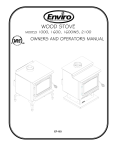
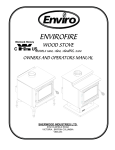
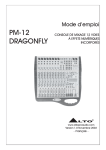
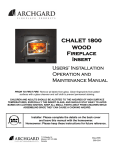
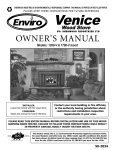
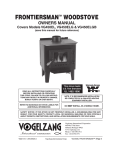
![PROTECTION] 5 E](http://vs1.manualzilla.com/store/data/005801803_1-bb6b523a92d2b05d032451f5b800ca8c-150x150.png)
